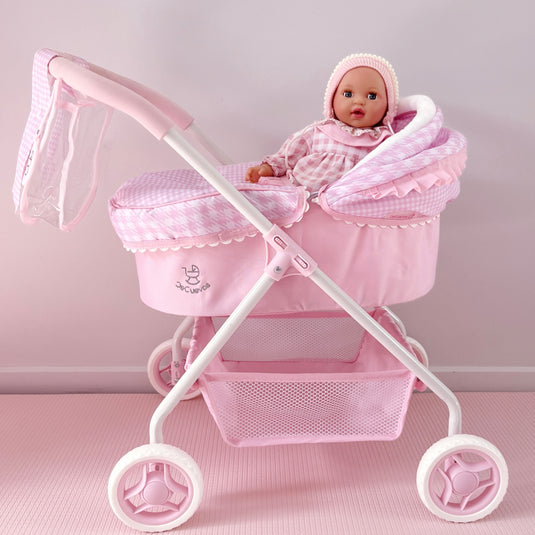Some Known Details About Dolls And Accessories
Some Known Details About Dolls And Accessories
Blog Article
The 8-Minute Rule for Dolls And Accessories
Table of ContentsSee This Report about Dolls And AccessoriesLittle Known Questions About Dolls And Accessories.Facts About Dolls And Accessories RevealedDolls And Accessories Fundamentals Explained7 Simple Techniques For Dolls And AccessoriesAll About Dolls And AccessoriesNot known Facts About Dolls And Accessories
When dolls are included in team play, youngsters practice waiting, sharing, and paying attention to others' concepts. Whether they're pretending to be a parent, sibling, or pal, kids discover just how partnerships workhow to support others, address disputes, and take care of a person else. These very early role-play experiences come to be the foundation for healthy relationships and relationships later in life.Duplicating comforting routines with a doll (feeding, shaking, putting to bed) can aid youngsters really feel tranquil and safe. These comforting rituals instruct them how to self-regulate. Looking after a doll can make a kid feel qualified and positive - doll accessories. It provides a feeling of obligation and control in a world that frequently really feels uncertain.
Dolls And Accessories Can Be Fun For Everyone
When children see dolls that reflect their race, heritage, and society, it reinforces a positive sense of identity. It states, "You belong. Your tale issues." Dolls also introduce kids to societies outside their very own, building respectful inquisitiveness and empathy for others. This is where inclusive play can bring about inclusive neighborhoods.
As Dr. Karyn Purvis, a leader in child growth and trauma-informed treatment, as soon as said: This powerful quote highlights exactly how play isn't simply funit's how children find out finest. The brain cables itself with rep. When a youngster is involved, joyous, and psychologically linked to an activitylike doll playthe mind enhances those connections quicker and a lot more meaningfully.
The Definitive Guide for Dolls And Accessories

Children need empathy, kindness, and imagination tooand doll play uses that. Yesdolls offer something distinct. They encourage open-ended narration and emotional connection in a manner few other toys do. Dolls are typically a youngster's first "buddy," assisting them practice relationships, build interaction abilities, and really feel comforted. Kids establish their sense of self from a young age.
Dolls And Accessories Can Be Fun For Anyone
Via play. Through satisfaction. With dolls that matter. Many thanks for joining us on this trip. Samantha Ong Samantha Ong is the founder of Joeydolls, a Canadian-based toy brand name on a goal to celebrate Oriental cultures with joyful, inclusive play. Influenced by her own experiences maturing without cultural depiction, Samantha creates dolls that help youngsters really feel happy with who they are while triggering interest and empathy in others.
Playing with dolls urges kids to talk more about others' thoughts and emotions, a research has discovered. The study suggests that playing fictional games with dolls could help kids establish social abilities, concept of mind and compassion.
The Single Strategy To Use For Dolls And Accessories
They were also much more likely to resolve the dolls in the second individual, talking with them directly, whereas the personalities on the computer screen they often tended to describe in the third individual. No distinction was observed between boys and ladies."Interior state language can indicate that a youngster is assuming concerning other individuals's thoughts and emotions while having fun with dolls," claimed Gerson.
And that they see language use in this respect is good verification of the hypothesis."Mardell added that the findings ought to use to any kind of role-play toy, instead than being details to Barbies."Children commonly begin to show signs of internal state language around the age of four.
Getting The Dolls And Accessories To Work
"It becomes essential for making and maintaining relationships, and just how they gain from their teachers, and parents."The research study additionally found that the kids had increased mind activity in the posterior remarkable temporal sulcus (pSTS) region when they spoke as though their dolls had thoughts and feelings. The pSTS region is believed to be associated with the advancement of social and emotional handling skills.
Childhood is not a fixed life stage; certainly, the definition, meaning and understanding of childhood years are all subject to adjustment. By the nineteenth century one of the most profound adjustments was the importance put on permitting kids to experience "the carefree joys" of childhood years via play tasks. Play was now thought about to be an important element of a great childhood.
In order to fully understand the definition of play, one need to additionally understand the importance of the doll. Dolls are much even more than playthings made to entertain young ladies.
Our Dolls And Accessories Ideas

It is only with archaeological examinations that researchers can intend to uncover and document the full variety of playtime experiences. Chronicling these experiences, and particularly the duty of dolls, is important for presenting a much more total image of childhood years throughout the 19th century. Alarcn, Sara E - high end dolls., "Youngster's Play: The Role of Dolls in 19th Century Childhood" go to this website (2007 )
Report this page